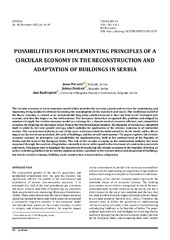Приказ основних података о документу
Possibilities for implementing principles of a circular economy in the reconstruction and adaptation of buildings in Serbia
| dc.creator | Petrović, Jana | |
| dc.creator | Pavlović, Jelena | |
| dc.creator | Radivojević, Ana | |
| dc.date.accessioned | 2023-11-13T20:42:11Z | |
| dc.date.available | 2023-11-13T20:42:11Z | |
| dc.date.issued | 2022 | |
| dc.identifier.issn | 2217-8066 | |
| dc.identifier.issn | 1450-569X | |
| dc.identifier.uri | https://raf.arh.bg.ac.rs/handle/123456789/1458 | |
| dc.description.abstract | The circular economy is a new economic model which provides the necessary goods and services for maintaining and improving living standards without increasing the consumption of raw materials and waste. The traditional model of the linear economy is viewed as an unsustainable long-term solution because it does not take waste treatment into account, and thus the impact on the environment. The European Union has recognized this problem and obliged its members to apply the circular economy model as a strategy for a climate-neutral, resource-efficient, and competitive economy. By adopting the European Green Deal at the Western Balkans Summit, the Republic of Serbia has committed itself to abide by the new growth strategy, which includes the application of the circular economy in all industrial sectors. The construction industry is one of the most environmentally harmful industries in the world, with a direct impact on the use of raw materials, life cycle of buildings, and the overall environment. The paper explores the circular economy concept, its principles, and possibilities for implementation, both at the national level of the Republic of Serbia and the level of the European Union. The role of the circular economy in the construction industry has been examined through the analysis of legislation currently in force with regard to the treatment of construction materials and waste. This paper aims to highlight the importance of employing the circular economy in the Republic of Serbia, as well as to define guidelines for its further implementation, especially in the reconstruction and adaptation of buildings. | sr |
| dc.language.iso | en | sr |
| dc.publisher | IAUS - Institute of Architecture and Urban and Spatial Planning of Serbia | sr |
| dc.rights | openAccess | sr |
| dc.rights.uri | https://creativecommons.org/licenses/by-nc-nd/4.0/ | |
| dc.source | Spatium | sr |
| dc.subject | circular economy | sr |
| dc.subject | building stock | sr |
| dc.subject | construction | sr |
| dc.subject | reconstruction | sr |
| dc.subject | adaptation | sr |
| dc.title | Possibilities for implementing principles of a circular economy in the reconstruction and adaptation of buildings in Serbia | sr |
| dc.type | article | sr |
| dc.rights.license | BY-NC-ND | sr |
| dcterms.abstract | Радивојевић, Aна; Петровић, Јана; Павловић, Јелена; | |
| dc.rights.holder | IAUS | sr |
| dc.citation.issue | 48 | |
| dc.citation.spage | 40 | |
| dc.citation.epage | 48 | |
| dc.identifier.doi | 10.2298/SPAT220301013P | |
| dc.identifier.fulltext | http://raf.arh.bg.ac.rs/bitstream/id/5015/bitstream_5015.pdf | |
| dc.type.version | publishedVersion | sr |

